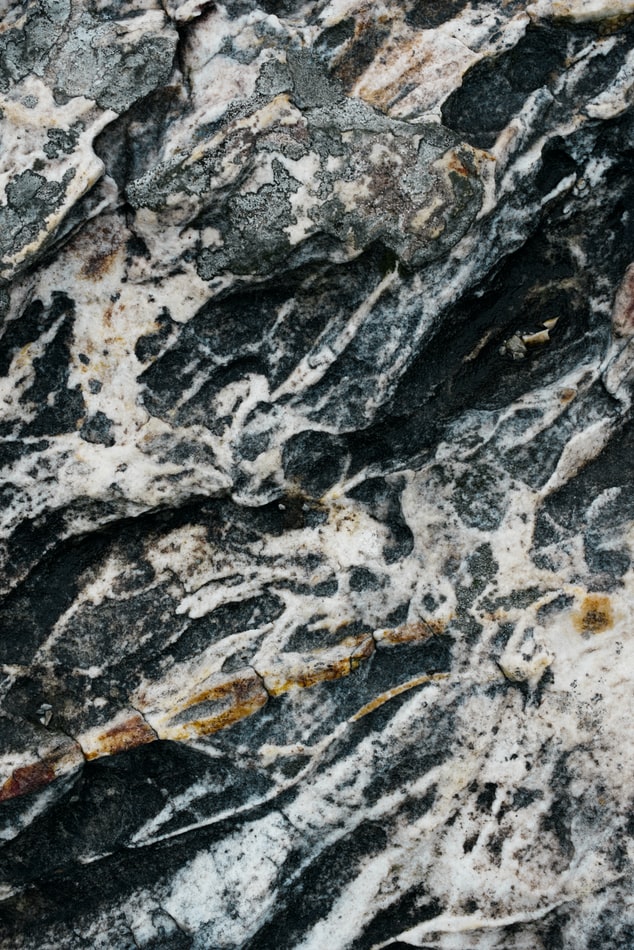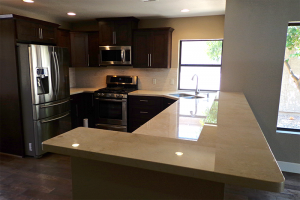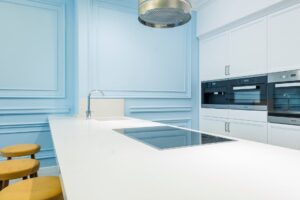Many homeowners like the aesthetic of natural stone surfaces when selecting kitchen or bathroom worktops. These materials, which frequently come in massive slabs, are available in an almost limitless assortment of distinctive patterns and colors. It may help you achieve a polished effect.
Natural Stone Countertops
Granite is one of the most prominent countertop materials on the market. It is a great way to add texture and depth to transitional-style, classic, or modern houses. When utilized in kitchens and bathrooms, marble, conversely, is synonymous with luxury and delivers high-end style. You may also use marble to spice up farmhouse style or contrast with slick surfaces for a modern aesthetic.
Both materials provide dimension and beautiful natural patterns to counters, but each has unique concerns for upkeep, longevity, pricing, and other factors. Let’s compare granite and marble countertops in further detail.
Origin
Solidification and cooling of magma deep below the earth formed granite over millions of years. Experts categorized it as an igneous rock because of the cooling of liquid magma. Granite originates as a tough substance during the process of heating and then gradual cooling.
Granite consists primarily of the extremely hard minerals quartz and feldspar.
Marble is a metamorphic stone because it is formed via the changing of another type of stone known as sedimentary rock. Sedimentary rocks form throughout time as sediments in the soil mingle with buried plant life under the earth. Under extreme pressure and heat, these sedimentary rocks transform into marble. This procedure integrates different minerals into the marble, which can give it appealing hues.
In essence, marble begins as limestone and evolves into marble. Marble is composed essentially of calcium carbonate, which is significantly softer than the granite components.
Which Is Better – Granite or Marble Countertops?
Choosing the right countertops is one of the most challenging decisions for homeowners when remodeling their kitchen or bathroom. Their choice is generally between utilizing granite or marble. That is why most individuals are perplexed when choosing natural stones. However, granite and marble are both gorgeous and appealing, and they may provide a desirable aesthetic aspect to your house.
It is difficult to decide which one is superior. So, how do you select which choice is best for you?
Here’s a look at what distinguishes granite and marble and what they share so that you can make the best pick for your countertops.
 Appearance
Appearance
These are both lovely countertop possibilities. The granules are visible in granite. They appear as colored specks. Thus, a granite slab may have a variety of colors – green, blue, pink, orange, red, and so on, often in medium to dark tones.
In marble, the pattern is more extensive. The hue appears to be uniform, with veins that intensify the color throughout it. A gray-blue marble slab may have deeper blue veins, whereas a gray-pink slab may have rosy-red veins.
Of course, beauty is subjective. Examine an enormous quantity of granite and marble slabs to determine which material appeals to you the most.
Durability and Hardness
We often regard granite as one of the most long-lasting natural stone surfaces. It is due to the heat-resistant material’s ability to withstand chips and cracks even when you place hot pots or pans on top immediately. It also resists scratches better than marble but may still etch. Spills on granite often clean off readily, but it’s better to wipe countertops promptly to avoid staining the porous surface.
Many people believe that marble is as delicate as it is elegant. Nevertheless, it is more rigid than its reputation since it resists damage from fractures and chips. The heat-resistant stone can withstand temperatures up to 350 degrees Fahrenheit; for anything hotter, use a trivet below.
However, some disadvantages of marble include discoloration and scratching. Because the softer stone is more prone to etching, always use a cutting board below while cutting or chopping food. Acidic food such as lemons, tomatoes, and wine, as well as acidic cleaning chemicals, may also etch your natural stone. It would be best to clean spills immediately to minimize stains from beverages, food, or watermarks.
Production
They remove granite and marble from the soil in large blocks, then sew them into thinner, more workable slabs. Because granite is more durable than marble, they carve it into thicker slabs.
Installation
Both granite and marble countertops are fitted comparably, beginning with a template translated to a slab, which is then cut to fit and completed. Installers use silicone glue to fix the slab straight into a plywood substrate or cabinets. They must drill holes for sinks and faucets, and these stone slabs are difficult to work with. A professional should handle both jobs.
Maintenance
These stone countertops can endure a long time with proper maintenance and care. Natural marble and granite require resealing, but how frequently depends on the surface type and how much use your kitchen receives.
Seal granite every two years to maintain its resistance to moisture. You can repair minor damage, like scratches, using color-matching epoxy. However, leave significant cracks for the professionals. Clean granite regularly with water and mild soap, but avoid aggressive cleaners, which may create scratches and even fade the sheen. Wipe up spills immediately to prevent discoloration, especially with oil-based products, which stain more quickly. Granite may endure a lifetime if properly cared for.
Every six months to a year, seal your marble. Although it will help prevent stains, it will not protect your surface against etching. Use a pH-neutral cleaner or one exclusively formulated for natural stone to clean marble. Because it is more porous than granite, cleaning up spills promptly will prevent discoloration and etching. Also, keep in mind that the sumptuous surface necessitates the use of a particular detergent to assist in eliminating stains. Marble can survive for a very long period if taken care of properly, although it is more prone to exhibit wear than granite.
Cost
Granite and marble are both considered more expensive countertop materials. Granite is often less costly, costing around three-fifths the price of the more expensive stone.
Prices, however, might fluctuate due to price changes and other causes. Cost is affected by the size, kind, labor, and other treatments. Higher grade stone, for example, or rarer shades of granite or varieties of marble, correlates to a more expensive product. Certain forms and bigger slabs of any material can boost the price, but smaller components or larger tiles are a more cost-effective option.
Profitability
Granite and marble countertops are not enough to make up for the difference in resale value. According to some, 53% of the money invested in a high-end kitchen makeover will be repaid.
However, granite and marble can increase the perceived value of a property by boosting the perceived value of the kitchen.
Environmental Concerns
Neither granite nor marble is an environmentally friendly material. While both may live for millennia with appropriate care, they need a significant amount of initial labor and energy to cut, mine, transport, and set up the stones.
Health Risks
Some granites may include trace amounts of naturally occurring radioactive elements such as uranium, radium, uranium, and thorium. Inhaling high concentrations of the noble gas radon has been associated to an increased risk of getting lung cancer. Radon can be emitted when these materials degrade over time.
Despite some concerns regarding the potential health dangers of granite countertops, it is widely assumed that they are safe. The Marble Institute of America maintains a library of publications that show the history of misleading claims regarding the safety of granite.
Heat-Resistance
Natural stones do not melt at extreme heat. Both types of stones required volcanic activity, as well as high temperatures and pressures. When put near a hot stove or oven, neither substance loses its color. Handle hot pots with caution, even if they are made of stone.
Stain Removal
The ability to remove a stain is dependent on whether the stone has sustained permanent and serious damage. Some stains are superficial, and you may clean them with a stain solution; others infiltrate into the stone’s pores and create irreversible alterations to the stone’s chemical makeup.
Which One Should You Choose
The question now is, which one should you choose?
The attractiveness and low-maintenance nature of anything vary from person to person.
Although they are both found in nature and recovered by quarrying techniques, they have unique features. You can distinguish granite and marble by their differences in porosity. Marble, as opposed to granite, is often softer and more porous. Granite is highly stain-, scratch-, and fade-resistant because of its crystalline structure.
Marble and granite are both solid and sturdy, as well as heat and scorching-resistant. Because of their biological roots, both may have a vast spectrum of color and design. In any case, a sample on display at the store may not be representative of the complete collection. Both surfaces require sealing because oily or pigmented substances can stain them. Both are produced by complicated earth interactions over long periods, making them appear unlike anything that could be manufactured.
Marble and granite may add beauty to countertops, backsplashes, and walls. Each is a rare and expensive gemstone.
5 Signs That Marble Countertops Are the Best Choice for You
- If you don’t mind devoting extra effort to upkeep.
- If you prefer the appearance of marble.
- If you are not concerned about scratches or dents on your counters, this is the option for you.
- If you won’t mind paying a little more for marble countertop slabs.
- If you can clean a lot and are confident in your ability to avoid the growth of stains on marble surfaces.
5 Signs That Granite Countertops Are the Best Choice for You
- If you want a more diverse range of colors and designs to pick from.
- If you prefer the appearance of the stone.
- If a lot of individuals use your kitchen frequently.
- If you operate on countertops with wild abandon and require a surface that can withstand all of this.
- If your work surface becomes soiled quickly.
Conclusion
Granite countertops are a fashionable addition to any house, whether traditional or modern. Because of the size and weight of marble, it is more expensive to have it cut and installed for a countertop than granite. Each material has its own array of benefits and drawbacks; choose the one that best meets your requirements. You can distinguish granite by its granular surfaces, which might be metamorphic or igneous in origin. Marble may be made from quartz or serpentine.
Marble, like granite, may have any number of tones on its surface, ranging from white to black. Both types of stone take on aesthetic aspects that are unique to their respective localities. They employ a template made of paper or cardboard, which is subsequently transferred to the stone surface. They cut and polish the slab after preparing it for use as a countertop.
Granite has a far longer lifespan than marble. They grade each gem’s quality on a scale of A+ to D+. Fragile stones receive a D, whereas powerful stones receive an A. Marble may be etched by acidic liquids such as lemon juice, tomato sauce, and citrus.
The average return on investment for a high-end kitchen makeover is 53%. Because granite is more durable than marble, they carve it into thicker slabs. Both have earthly origins and are acquired using quarrying procedures, yet they each have distinct qualities. Granite is the most durable material since it is scratch-resistant and requires little care. Both are resistant to fire and extreme heat, making them suitable for building.
Choose the Best Countertop Material for Your Kitchen
When comparing granite vs. marble countertops, both natural stone counters are beautiful, but granite outperforms marble in terms of increased durability and ease of upkeep. While these recommendations can help you decide which surface is ideal for your lifestyle, you may want to use an online marble or granite visualizer to determine which one best matches your home.
If you want to learn more about natural stone countertops, you should contact Granite Dude. We have a team of experienced professionals to offer expert advice and help with installation.









